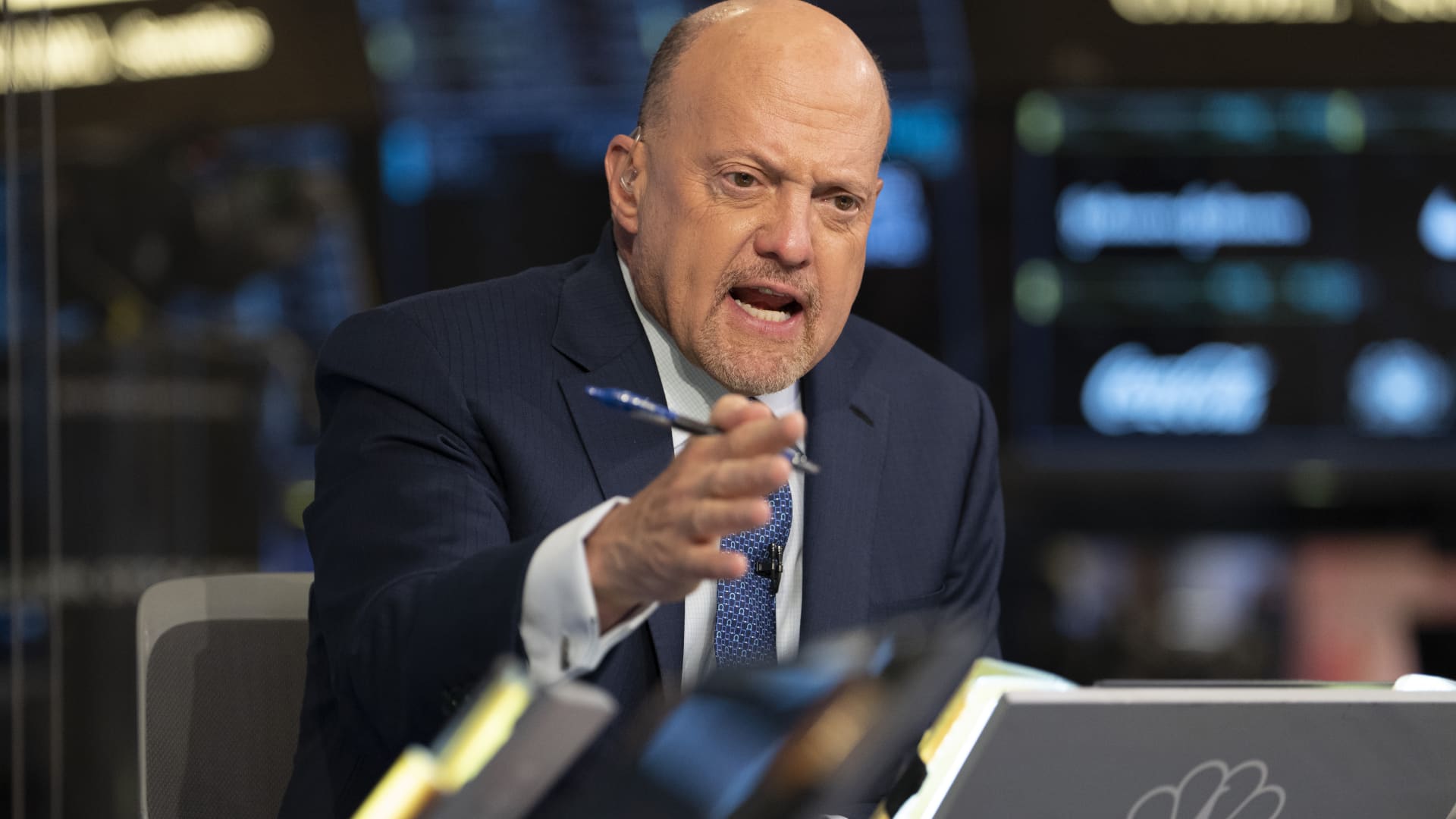
In the Investing Club, we take a long-term view on our holdings. But in the short term, there can be unfavorable factors that impact a company’s fundamentals, and a winning stock can turn into a losing trade. This is something we have espoused and stressed in past commentary. “Buy and homework,” as Jim Cramer likes to say. That’s his take on “buy and hold” investing because you never want to be static. You always want to be stress-testing your holdings, especially the ones that aren’t working. Human nature may tell you to ride the stock down a bit further in hopes of a reversal, but it’s best to come to terms with your losses and take them as learning opportunities when the situation calls for it. This can allow you to free up capital for the next possible buying opportunity. As we’ve pointed out in the past, you can always make your money back on another stock. Hoping and praying for a turnaround is not a strategy. It may be tempting to consider selling when a stock it’s steadily falling well below your cost basis, but that’s not enough of a reason to move on. We don’t care about where stocks came from, we care about where they are headed next. But there are some tell-tale markers that can determine when it’s time to start thinking about bowing out rather than hold on to a stock that could cost you further. When managing our own portfolio, these are three questions that we ask ourselves that could also be beneficial to Club members. We also included examples of the lessons we learned in exiting certain positions that no longer fit our investing criteria or the brutal market environment this year. It’s kind of the flip side of our story earlier this month on when to trim winners . 1. Have the fundamentals of a company changed? A break in a company’s fundamentals can come in many forms, including a change in forward guidance, a decline in profits or a shift in a company’s strategy that worsened the business. We saw some of these factors at play with former Club holding American Eagle (AEO), which ultimately led to our decision to part ways with the specialty retailer. When we first bought American Eagle, the retailer recorded a strong performance in the first half of 2021, when it had benefitted from consumers spending their Covid pandemic stimulus checks. Strong consumer demand for its loungewear led to sales growth, which improved the retailer’s profitability and operating margins. We bought some more into some retail weakness heading into 2022, before the full extent of the inflationary headwinds that came to define this year came into focus. But as economic uncertainties and what turned about to be anything-but-transitory inflation started to kick in, American Eagle was operating in a different environment. The company’s quarterly earnings started to shed light on troubles the retailer had been facing. Higher input costs ate into margins, supply chain issues persisted due to factory shutdowns in Asia and consumer preferences started to shift away from what was popular during the pandemic. The retailer took an $80 million loss due to elevated freight costs in its fourth quarter of 2021 reported on March 2. Management provided a cautious forward guide for 2022, expecting a lower operating profit in the range of $550 million to $600 million compared to 2021’s adjusted operating profit of $603 million. Rising prices also spurred concerns that consumers would scale back their discretionary apparel purchases. With this, American Eagle no longer had pricing power, or the ability to increase prices on its items without impacting consumer demand. With multiple stressors on the retail sector, we exited the rest of our AEO position on May 19 , one day after getting rid of half. We took the losses in what we call a high-grading move , shifting money into a stock we felt was right for the time: Johnson & Johnson (JNJ). Health-care stocks tend to be resistant to economic downturns because people have historically been loath to skimp on their wellness. Again, this goes to the idea that you cut losses and start to build into better names. (AEO has lost about 50% year to date.) Lesson learned: From our American Eagle holding, we were reminded that you can’t be worried to sell when the original story behind owning a stock changes. As a matter of principle, when you buy a stock for a certain reason, that investment thesis should hold true throughout the time it’s in your portfolio. 2. Were promises made and never delivered? We lost conviction in payment processing company PayPal (PYPL) because management was doing a poor job at setting expectations around business growth as it was transitioning out of a pandemic economy driven by e-commerce. One of PayPal’s pressure points was its longer-than-anticipated separation from eBay (EBAY), which eventually revealed a much larger impact on growth than what management had reported. After eBay and PayPal separated into two independent companies in 2015, eBay started to transition to its own payments system and away from using PayPal’s platform. This was a nastier separation than expected, making it unclear how it could impact PayPal’s growth rate. At the time we held PayPal, management had promised growth after the separation — but revenue excluding eBay actually declined. PayPal CEO Dan Schulman provided upbeat comments in a November 2021 “Mad Money” interview with Jim, leading us to believe that its problems were behind the company. But that was followed by earnings misses and weak forward guidance, which made us question management’s credibility. In the fourth quarter of 2021 , which reported in February, PayPal provided mixed results and lower-than-expected estimates for the first quarter. PayPal delivered $1.11 earnings per share versus $1.12 consensus estimates and forecasted 2022 revenue growth of 15% to 17% when analysts had expected 17.9% growth in 2022. In the first quarter of 2022 released in April, we were discouraged by PayPal’s lower net revenues of $6.5 billion versus the previous quarter’s net revenues of $6.9 billion. Another red flag was PayPal’s speculation around acquiring social media platform Pinterest (PINS). What would have been the biggest acquisition of a social media platform ended in PayPal addressing what it called “market rumors.” PayPal announced in an October press release that it wasn’t pursuing an acquisition with Pinterest, sparking concerns of how it would increase new active accounts. Apart from PayPal’s multiple execution problems, we also considered how macro challenges could weigh on the company. PayPal’s post-pandemic business had trouble keeping up with its strong pandemic performance. We were concerned about a slowdown in e-commerce growth, supply chain challenges, and the broader market turning against tech stocks. (PayPal’s stock price has fallen about 50% year to date.) We also weren’t too keen on PayPal’s exposure to cryptocurrency through its crypto platform. In the first half of the year, crypto had been selling off, so there was uncertainty around how much PayPal could be impacted. Lesson learned: When a company reports a number of bad quarters in a row, even if management says everything is OK, it’s time to move on from the situation because the stock will likely sit in the penalty box for an extended period. 3. Are the Fed and the market working against you? The phrase, “don’t fight the Fed” refers to positioning your investment portfolio with companies that could benefit from the Federal Reserve’s monetary policy, or at least not get crushed by it. We think this is a good mantra to follow because the direction interest rates take can have a considerable influence on the market. In 2020, the Fed lowered interest rates to near zero and took other extraordinary steps to try to stimulate the economy in the early days of the Covid pandemic. This created liquidity, much of which made its way into the stock market. When Wall Street anticipated a change in the Fed’s monetary policy at the start of 2022, stocks steadily sold off, eventually going into a bear market. In early April, two of the most dovish Fed Governors gave separate speeches describing the harmful effects of inflation. We took their comments seriously and viewed this event as a sell , sell , sell moment for higher multiple and economically sensitive stocks. Their words meant that the Fed had finally gotten serious about raising interest rates and slowing the economy down to combat inflation. Over two days back then, April 5 and April 6, we exited Nucor, lightened up on Microsoft (MSFT) twice, and trimmed Amazon (AMZN), Ford (F), and Marvell Technology (MRVL). Lesson learned: In the midst of a Fed policy change, you can’t be afraid to sell a stock that has fallen because of a shift toward a tightening cycle that originally benefitted from a loose monetary policy. (Jim Cramer’s Charitable Trust is long AMZN, F, JNJ, MRVL, MSFT. See here for a full list of the stocks.) As a subscriber to the CNBC Investing Club with Jim Cramer, you will receive a trade alert before Jim makes a trade. Jim waits 45 minutes after sending a trade alert before buying or selling a stock in his charitable trust’s portfolio. If Jim has talked about a stock on CNBC TV, he waits 72 hours after issuing the trade alert before executing the trade. THE ABOVE INVESTING CLUB INFORMATION IS SUBJECT TO OUR TERMS AND CONDITIONS AND PRIVACY POLICY , TOGETHER WITH OUR DISCLAIMER . NO FIDUCIARY OBLIGATION OR DUTY EXISTS, OR IS CREATED, BY VIRTUE OF YOUR RECEIPT OF ANY INFORMATION PROVIDED IN CONNECTION WITH THE INVESTING CLUB. NO SPECIFIC OUTCOME OR PROFIT IS GUARANTEED.




